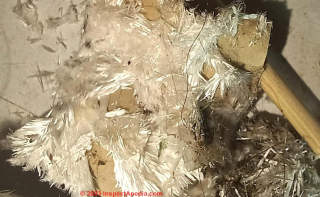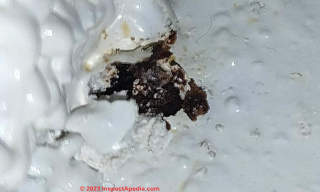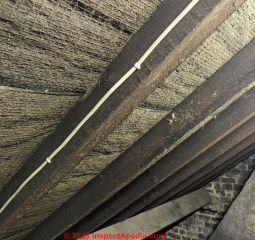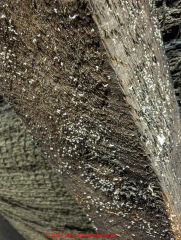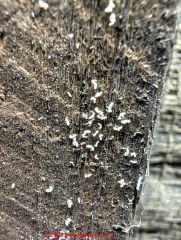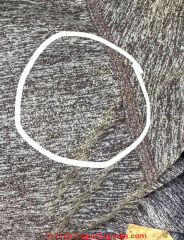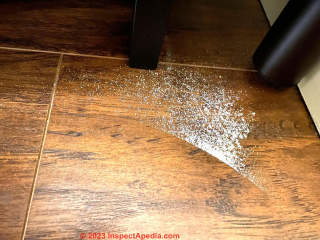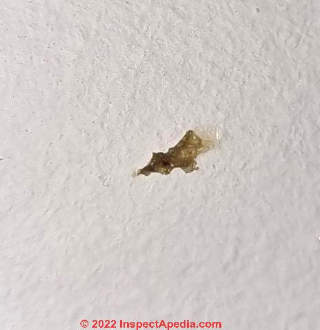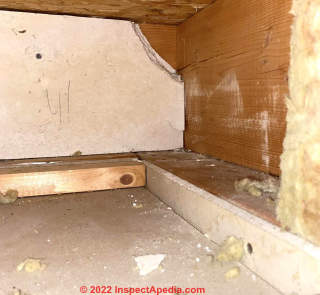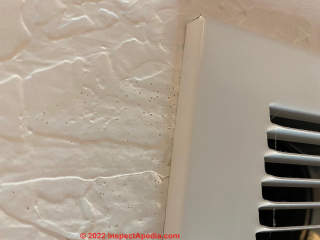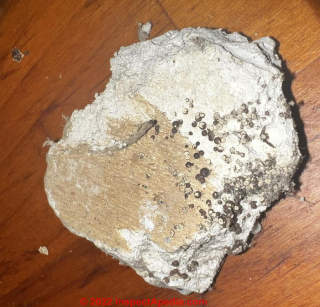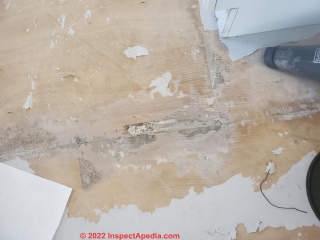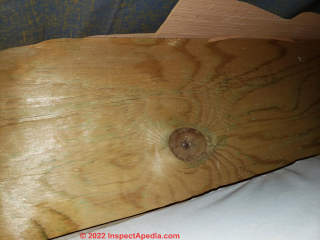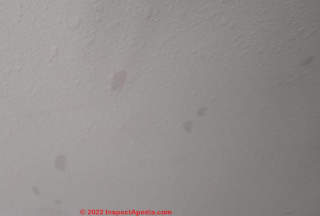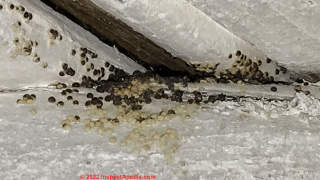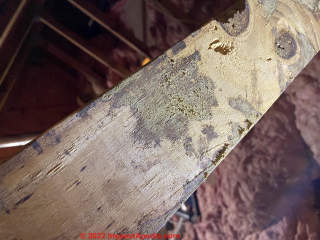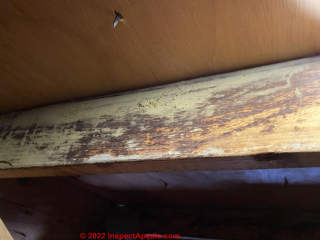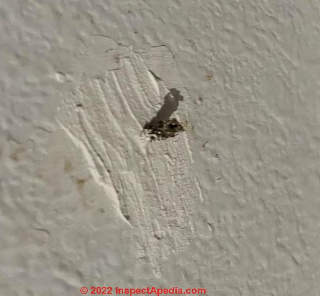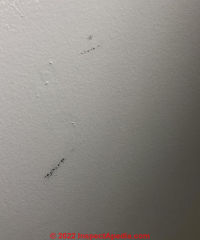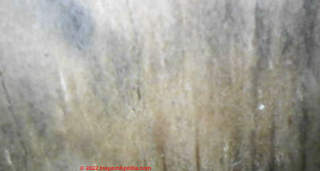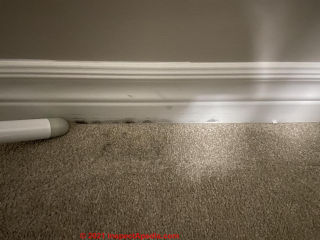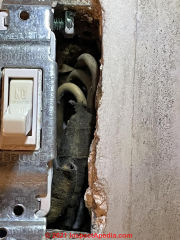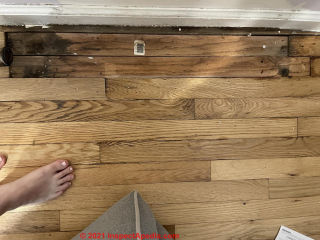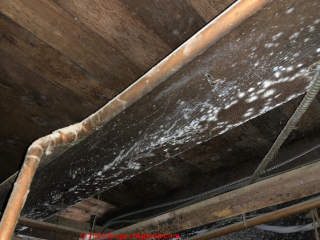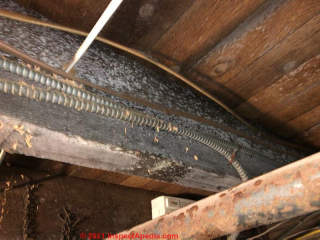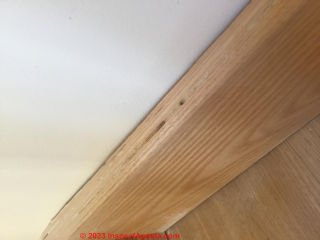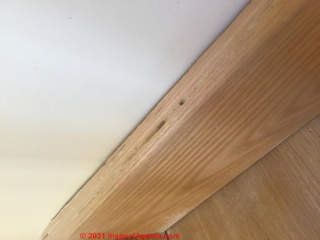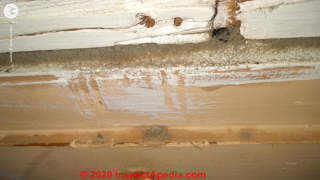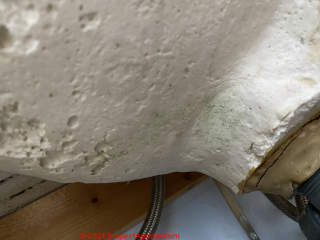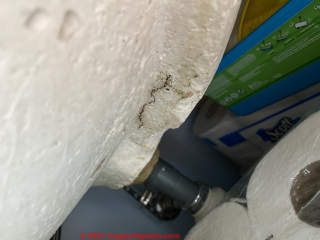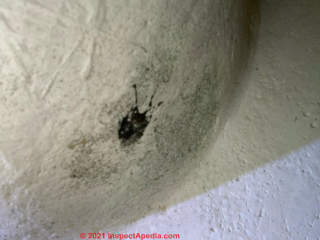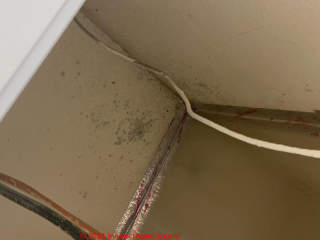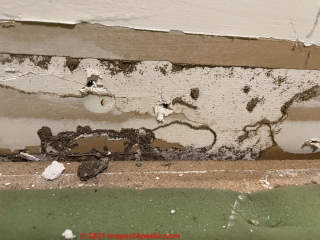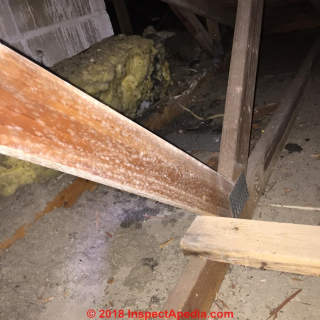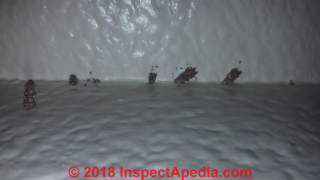 Stains & Growths that are Not Mold, FAQs
Stains & Growths that are Not Mold, FAQs
Q&A on white, black, yellow stains, harmless black mold
- POST a QUESTION or COMMENT about how to identify stuff in buildings that is not mold but may be mistaken for it. Stains, deposits, growths, etc.
Questions & answers about distinguishing mold contamination from other building stains, debris, or particles.
FAQs help distinguish between harmful and harmless indoor stains, growths, deposits, dusts, & particles.
Page top photo: possible termite mud tubes protruding from a finished wall/ceiling surface. This is not mold, but damp conditions inviting insects into a building can also invite mold.
This article series describes indoor stains and deposits that are not building mold or in other examples, harmless cosmetic mold. When investigating a building for a mold problem, you can save mold test costs by learning how to recognize Stuff that is Not Mold or is only Harmless Mold but may be mistaken for more serious contamination - save your money.
InspectAPedia tolerates no conflicts of interest. We have no relationship with advertisers, products, or services discussed at this website.
- Daniel Friedman, Publisher/Editor/Author - See WHO ARE WE?
Q&A on scary-looking, usually harmless indoor stuff mistaken for mold
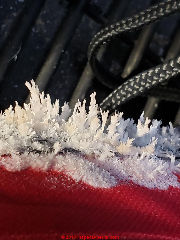 These questions & answers about stains and growths in buildings that are not mold were posted originally
These questions & answers about stains and growths in buildings that are not mold were posted originally
at MOLD APPEARANCE - STUFF THAT IS NOT MOLD - be sure to check out the examples and photos given there.
Don't hire an environmental consultant if your only concern is the "not-mold" stuff you see here and if there are no health or air quality complaints.
Save your money, don't bother testing the things you see in this article unless we indicate that the material is mold or another hazardous substance AND that the substance is present in a large area (more than 30 sq.ft. of contiguous mold) that requires a costly cleanup.
For photos of stuff that is indeed mold contamination in buildings,
see MOLD APPEARANCE - WHAT MOLD LOOKS LIKE. So many people have called us to look at things that are not mold that I'm offering some photo tips below.
Photo: stains and fluffy stuff on a light fixture are not mold - discussed below.
[Click to enlarge any image]
On 2023-08-24 by InspectApedia Publisher - looks like synthetic fibers found in plastic tote
@Mike r,
A photo cannot be the final word on what a fiber is but that looks like a synthetic fiber. How old is the Rubbermaid Tote? I'm not sure what might be a concern other than making a mess to be cleaned up. I can't say that I see mold.
On 2023-08-24 by Mike r
Found whatever this is growing inside a Rubbermaid tote. Should I be concerned?
On 2023-06-12 by InspectApedia Publisher
@Miss.Robinson,
Looks as if there is or was a leak above that point OR that someone painted over prior leak damage or other crud.
On 2023-06-12 by Miss.Robinson
Just would like you're thoughts on the nasty gauk on my celling. Seen a small spot tried wiping it off, nothing. So I started picking at the bump opened it up and I almost #1
On 2023-05-21 by InspectApedia Publisher - straight pit saw marks on the sides of rafters indicate age of over 100 years
@Rob,
Thanks for the added detail about your 100 y.o.+ house and white particles on rafters. I agree it doesn't look like mold and may well be harmless, but it'd sure be instructive to understand what it is.
A DSLR in Macro mode might work.
About the saw kerfs on your rafters, in Europe the pit saw dates from around 1590 (Dutch, windmill operated, Cornelis Corneliszoon (1550–1607).
On 2023-05-21 by Rob
@InspectApedia Publisher, thanks for your follow-up. To clarify, these white things appear on pretty much all sides of all the beams on the south-facing roof (some more than others). There are some on the north-facing beams, but much fewer. I'm not aware of anything being attached to the beams.
The house is a Victorian terrace in London (UK), so over 100 years indeed. As far as I'm aware there haven't been any leaks up there, certainly not in the 11 years that I've owned the house.
I don't have a magnifying glass unfortunately, I could try a DSLR for better quality if you think that may help?
I should note that these things aren't in the wood, they are on top of the surface and not particularly well-attached.
I couldn't see anything else that looked like mold or anything else unusual, so if they typically grow in communities of different types, I imagine it's probably not mold.
I hope that answers everything!
Thank you,
Rob
On 2023-05-21 by InspectApedia Publisher
@Rob,
This photo is very helpful to give some context.
It looks as if there was never any ceiling material fastened to those rafters so whatever the white material is it's not a remnant from drywall or a similar product.
See if you can use a magnifying glass to get a careful and very sharp and large amount of some of that white debris.
By the way those are some nice straight pit saw marks on the sides of those rafters which probably tells us something about the building age. I suspect this building is more than 100 years old.
What do you know about the history of the building and tell me it's location by country and city.
On 2023-05-21 by Rob
@InspectApedia Publisher, thanks for your reply. Here is a more distant image. It's mostly on one side of the roof beams. I could believe it's just dust, but possibly also some sort of bug casings.
On 2023-05-21 by InspectApedia Publisher - can you identify this white stuff on my roof beams?
@Rob,
I've looked at your close-up but unfortunately, zooming in to try to examine those white particles, it's really too blurry for me to be sure what I am seeing.
It's possible that that's a mold or fungal fruiting body but it would be unusual to see mold growth that's so uniformly distributed on two sides of a piece of wood and nowhere else.
Do you know if that white material appears uniformly on all of the framing in that area or just on individual members?
Do you know what was attached previously to that surface that could have left any white debris?
Do you know the moisture and leak history of the area?
And finally, if conditions are right for mold to grow in a building it would be quite unusual for only one genera and species to appear, so finding others in the same or other locations on mold-friendly materials such as wood or paper or drywall would be helpful confirmation.
On 2023-05-21 by Rob
@InspectApedia Publisher, sorry, to answer your question, it doesn't feel damp and I can't see any stains. These things are probably up to 1mm long and for the time being I have hoovered them up, to see if they return. Any thoughts would be greatly appreciated!
On 2023-05-15 by InspectApedia Publisher
@Rob,
I'm uncertain. Is that a wet or damp area? Any leak stains?
It would be a bit unusual to see mold stopping at edges of a beam or rafter.
A sharp close-up and a distant, perspective view would help.
On 2023-05-14 by Rob
Hi there, any chance someone can identify this white stuff on my roof beams? Thanks!
On 2023-03-14 by InspectApedia Publisher - clothing stain likely salt deposit from sweat
@Lizzy,
Most likely a white powdery substance found in the armpits of clothing is salt from dried perspiration.
It would never be mildew: an obligate parasite form of mold that grows only on living plants.
It's not likely to be mold on cloth unless your clothing has been left damp or wet for some time or left in a damp or wet location.
On 2023-03-14 by Lizzy
I found this powdered sugar like substance on the armpits of many of my shirts. I apologize for the terrible photo; this is the only item I thought to take a photo of. I cannot find a similar mold or mildew online.
Thanks!
On 2023-02-17 by InspectApedia Editor - white powdery substance on the side of my bed
@Barbara Shepherd,
Hard to tell from just one photo but a couple thoughts:
I'm assuming the arc line is from you wiping up some of it and that is not showing the pattern the way you found it.
Could be insect damage of some sort. You mention it's not close to a wall or seam but have you looked above it to see if there's any evidence on the ceiling?
Is there anything nearby that could be chafing or rubbing that would be leaving this debris? Something attached to or by your bed? We once had a mattress pad that started to break down leaving a white residue.
Do you have any pets that may be tracking it in when they're by the bed?
Have you looked at it under magnification to see if you can tell if it's wood fragments or plastic or something else?
How often does it reappear?
On 2023-02-17 by Barbara Shepherd
I keep cleaning up this white powdery substance on the side of my bed. I can’t find where it is coming from. It’s in the middle of a laminated tile, not close to a wall or seam. What can it be?
On 2023-01-04 by InspectApedia Publisher - might have to use a magnifying glass
@Emma,
Thanks for the challenge. I don't recognize that particle as insect material - so I'm not sure what they are.
You might try looking at one of the particles through a magnifying glass - see if you can photo an enlarged version.
On 2023-01-04 by Emma
Can anyone please tell me what this is ? I've had random ones pop up all over different walls of the house. They look like bogeys and have the same texture but I know there not as some are up too high.
On 2022-12-24 by Peter
@InspectApedia (Editor), thanks! I agree that this must be the case. All the best,
On 2022-12-24 by InspectApedia (Editor)
@Peter,
That looks like drywall dust and scrapings to me -
On 2022-12-24 by Peter
Is this mold or some other white staining? I found it on a rim joist in the second floor behind the rock wool isolation.
On 2022-05-17 by Friedmandaniel911 (mod) - paint defect not mold
@J,
That's not a leak stain and it doesn't look like mold to me; perhaps a contaminant - particulate debris in the original paint.
I suggest wetting a clean cloth or paper towel with windex or a similar mild cleaner and then seeing if the spots wipe off - if not, it's a little defect in the paint.
On 2022-05-16 by J
My wife sent me this picture - this is around a vent on the ceiling in one of our bedrooms (drywall ceiling). She is convinced it is mold - I'm skeptical. Any thoughts?
We have had a roofing inspector look at this area previously due to concerns (when we bought the house there was some very slight staining near the vent that we painted over several years ago) and no issues were found.
I've been in our attic during a rainstorm and never found any signs of roof leaking or any discoloration in the insulation that sits above the ceiling vent.
On 2022-05-05 by Inspectapedia Com Moderator
@Lesa,
And experienced home inspector or contractor can answer the questions that I posed by direct inspection.
About ventilation, you're correct that you don't have a working roof vent system and you have a faux ridge vent.
There are products that can provide thieves venting even when there's no soffit overhang. Search this website for roof ventilation to see a series of articles that describe different options.
On 2022-05-05 by Lesa
 @Inspectapedia Com Moderator, thank you for that feedback- very helpful and interesting. Do you have any suggestions on how to go about answering those two great questions you mentioned?
@Inspectapedia Com Moderator, thank you for that feedback- very helpful and interesting. Do you have any suggestions on how to go about answering those two great questions you mentioned?
I took the photo during a rain storm, and with a flashlight in hand, observed for a good 10 minutes to see if there's any drips or water leaving the boards or rafters. Is it safe to say that if there was a leak of any volume, I'd be seeing it drip in that situation? I couldn't get close enough to feel the boards.
Where I can see plywood between the boards, the plywood appears to be clear looking. There's no evidence of water damage or leaking on any of the surfaces below the attic ceiling, but there's an old plaster ceiling that way left up there so the water would have a few layers to penetrate before I'd be seeing it on my second floor ceiling.
Also the immediate ceiling is lined with fiberglass batts. Looking at some of the rafters near the ridge, there's some sparkling quality- is that typically efforvescence?
When the roof was done 9 years ago, I didn't pay attention or know what I know now, and it appears the roofers put on a ridge vent but it doesn't appear open, as there's no daylight.
There's one sizable gable vent open on the front but the previous owner blocked the back vent when an addition was added. Soffit vents arent feasible (it was a Greek revival originally I believe) so the plan is to add an exhaust roof vent to draw from the Gable for intake.
Im concered there's not enough ventilation, currently. I should maybe add that I'm located in upstate NY.
Thank you so much for your reply and feedback.
On 2022-05-04 by Inspectapedia Com Moderator - sparkly mineral salts and white blobs on the wood
@Lesa,
The white blobs are remains of mud-dauber wasp nests that have been removed.
I think this home originally had wood shingles, with roof sheathing set spaced apart using pit-sawn boards. Consistent with the date you report.
We can see, between the boards, the plywood decking you report and that was added atop the original roof decking boards.
Those "mineral salts " may be just that if they're near were a masonry chimney is or was located. Mineral deposits are themselves harmless; what's important is the information they tell us about the home.
I see signs of a history of roof leaks - no surprise on an older home.
If you see that water stains are also on the under-side of the plywood then roof leaks have occurred after that material was installed.
The important questions are
- are there ongoing leaks that need to be fixed
- is there rot that needs to be repaired.
On 2022-05-04 by Lesa
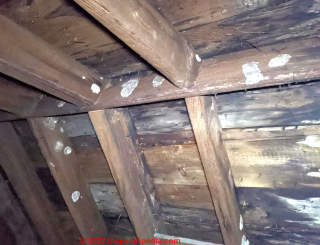 I have an older home. There's plywood decking over these old wood boards and architectural shingles over that. There's a center chimney near the scuttle access where this photo was taken.
I have an older home. There's plywood decking over these old wood boards and architectural shingles over that. There's a center chimney near the scuttle access where this photo was taken.
There appears to be some sparkly mineral salts on the wood near the masonry and round white blobs scattered throughout on the rafters.
The darkening of the wood I'm hoping is just from age or oxidation vs but possibly old water damage (the house is circa 1850). I can't access the much of it to feel the surface, but from what I can see and feel close to the shuttle access, it's dry. No known or visible leaks.
Id love your opinion of what it looks like in the photos. Thank you
On 2022-05-25 by InspectApedia-911 (mod) - sheetrock from hole in wall has mold on it
@William O’Sullivan,
Possibly, I think the thing to do is to actually look into that opening at the other surfaces as well as to review the leak history of the building.
On 2022-05-25 by William O’Sullivan
I found a hole in the Sheetrock behind my dresser. I found this broken off piece on the floor near the hole. I’ve had unexplainable heath issues for several years now, and I’m wondering if maybe this could be toxic mold.
On 2022-04-13 by Inspectapedia Com Moderator
@Virginia,
Possibly, but frankly I couldn't see much of anything in the photo.
If you're tearing up old sheet flooring you might want to use the InspectApedia.com search box to find information and warnings of
asbestos hazards in sheet flooring
On 2022-04-12 by Virginia
Hi, I have this on my wood subfloor. I can't telling if it could be mold? We removed a vinyl sheet. Concerned since we were not fully anticipating this on removal. Had air purifier and masks but no drop cloths. Any ideas or suggestions? Trying to know if we are okay to install new lvp or need a pro to come out
On 2022-02-06 by Inspectapedia Com Moderator - black green white red or other colored stains might be the effects of current or prior mold damage
@Anonymous,
Any stains in wood that are black green white red or other colors might indeed be the effects current or prior mold damage.
For the face of your photos and realizing that we have not any surrounding information about the building age, like history, location, or the extent of staining, I'm left getting only a general answer:
If this is the only stain, and if it is under the finish of the floorboard and if there's no leak history or ongoing leaks, then it's not at all likely that the stain in your photo is a concern.
On 2022-02-06 by Anonymous
SO is the greenish color on this floor board anything to be concerned about . My boyfriend doesn't think so , Ibelieve otherwise . Your thoughts are appreciated greatly.
On 2022-02-03 by Inspectapedia Com Moderator
@Brian,
Sorry, but from the photo alone we can't reliably identify those darker spots on your wall. There could be a splash up or, most likely, a leak from the wall cavity..
You would need a more careful and expert on site inspection and possibly even destructive inspecting such as cutting it just opening in the drywall to examine its cavity side. It's probably not justified to do that unless this problem is worse than what we see in your photos.
On 2022-02-02 by Brian
Mysterious substance on living room and kitchen walls - Please help identify! Mold removal expert says it is not mold.
On 2022-02-04 by Inspectapedia Com Moderator - mold after remediation shows inadequate treatment
@Beth M.,
Fungal growth
and
Mold growth
Are synonyms .
I think the mold growth in your basement after spraying a fungicide is a good example of the Limited usefulness of Simply spraying over a moldy area.
Most effective procedures to remove the mold, clean the exposed surfaces, then if you want to use a bunch of subtle sealant that's fine. But you must also correct the cause of the mold growth or it will eventually return.
On 2022-02-04 by Beth M.
Does this appear to be mold or a different type of fungal growth? We had mold remediation done last year. The air sample had aspergillus/penicillium, chaetomium, cladosporium, and basidiospores. Could it be one of those regrowing?
Previously these areas had a dark growth when we bought the house. I’m unsure if the light color growth is dead material from the previous treatment, or if this is new growth that then matures to a dark color?
The growth is on a basement ceiling that was painted before we owned the home, and then sprayed with a remediation product by a professional company. Thank you for your insight.
This additional photo with the growth next to my pinky finger is for scale. Thanks again for any insight you can share.
On 2022-01-25 by Inspectapedia Com Moderator - can mold grow on metal
@Rose,
There are species of mold that will grow on almost any surface, but when mold is found growing on stainless steel, the mold will actually be growing on organic debris, for example food spills, that is in turn on that metal surface.
If you can't clean off the spots with normal cleanser and cleaning methods, it's not at all likely to be mold. More likely something is burned on or is etched onto the surface.
On 2022-01-25 by Rose
Is this mold? It’s only growing on the metal, and despite scrubbing with vinegar and baking soda I couldn’t get any of it to come off
On 2022-01-18 by Inspectapedia Com Moderator
@Taz,
Knowing the mold genera/species won't change what's needed one bit, but still can be interesting.
If you decide to test do let me know what species are identified: I'd bet there are at least 3; if you're clever you can capture all 3 close to one another on a single bit of tape - MAYBE - cutting the lab cost from 3 to 1.
Remove the mold.
Find and fix the cause.
On 2022-01-18 by Taz
@Inspectapedia Com Moderator, thank you for the prompt response! Yes it does flake off and I plan to take a sample to get it tested. Heres another photo for reference!
On 2022-01-18 by Inspectapedia Com Moderator
@Taz,
That looks like a roof rafter (upside down photo - not your fault) that has white, brown, black, and yellow-green (chartreuse) discoloration, all of which might indeed be mold.
If you can wipe some of it off with a finger it's probably mold growth. (Don't put a moldy finger in your eye)
On 2022-01-18 by Taz
Would these yellow deposits be considered mold? Located in a NJ attic on the rafters. Attic has gable vents and soffit vents, roof is on older side but no visible evidence of any leaks. Could not figure out what this would be.
On 2021-12-26 by Inspectapedia Com Moderator - black small circle on my wall
@Yolanda,
Unfortunately when I enlarge your photo it's a bit blurry and I can't really make out what that black material is. It could be a fungal growth behind the wall if in fact there's a water source.
On 2021-12-26 by Yolanda
I had a black small circle on my wall. I thought it was a mud splatter or something. A few daws later it had grown out of the wall like poop. I flicked it off into a trash bag and sprayed the wall with bleach. The next day it was back again.
So this time we poured peroxide on it and took scissors to make the hole bigger and only found the framing of the house inside the wall. (I’m renting by the way).
We covered the hole with plaster and the next morning the black long thin poop type thing had grown back within less than 12 hours. As you can see from the shadow, it is long
On 2021-12-31 by Inspectapedia Com Moderator
@Ajay,
The pattern of those marks looks to me more like an impact or scrape.
On 2021-12-31 by Ajay
Are these black stains mold? They're from about midway down a bedroom wall, a bit below a wall-mounted air conditioner. The stains smell a bit musty but neither feels slimy or powdery; they both feel stuck on to the wall, sort of like paint.
On 2021-12-06 by Danjoefriedman (mod)
@Renan,
Possibly: I don't know what we're looking at in that blurry photo: furniture, drywall, wood paneling or something else .
On 2021-12-06 by Renan
Is this mold?
On 2021-10-01 by Adelaide
@inspectapedia.com.moderator, thank you for your reply and for this site! So appreciated!
On 2021-10-01 by inspectapedia.com.moderator - investigate small stains for signs of water leaks or spills: possible hidden mold
@Adelaide,
What we can see is trivial and might not even be mold;
I advised looking for evidence of leaks or spills - that could in turn have caused hidden mold that's more extensive.
On 2021-10-01 by Adelaide
@inspectapedia.com.moderator, thank you so much for the quick reply! By trivial, do you mean it’s not enough to worry about or that we can’t really go by what we can see with the naked eye? Thank you again!
On 2021-09-30 by Adelaide
@inspectapedia.com.moderator, thanks so much for your quick reply! Regarding the part about it being trivial, do you mean that it’s not that bad OR do you mean we can’t go by what we can see with the naked eye? It does extend further but is less prominent. This was there when we moved in 3 months ago, though not as bad, so I chalked it up to scuff marks. No spills since, I don’t think, with a crib there. Thanks again!
On 2021-09-30 by inspectapedia.com.moderator (mod)
@Adelaide,
could be, though it could also be a thermal bypass leak; if it's mold, what we can see is trivial; but look for leaks or water entry or prior spills;
On 2021-09-30 by Adelaide
Hi! Found this along the baseboard of one wall in master bedroom (there’s an ensuite bathroom). There are no registers along this wall, which is shared with a staircase. Could this be mold? Thank you in advance!
On 2021-09-18 by inspectapedia.com.moderator (mod)
@Ruth,
That looks more like dirt.
On 2021-09-18 by Ruth
This light switch is in the hallway near the thermostat, a/c filter, and bathroom. The bathroom had mold on the walls/ceiling that we’re taking care of. Is this also mold?
On 2021-08-29 by inspectapedia.com.moderator
@Dave,
The photo is a little blurry but I think I see fiberglass insulation and a bunch of brown material that could be fresh from insect damage or possibly mud.
You need to look around a little more or perhaps see if you can get a sharper shot. From this photo I can't say that the tan stuff stuck onto the pink fiberglass is anything more than loose fill cellulose;
If by some chance you were asking about those inky black spots in a row on the OSB subfloor, that's a manufacturing mark or stamp.
On 2021-08-28 10 by Dave
This is in my 14 year old home basement in one of the unfinished rooms. Any ideas what it is? Thanks.
On 2021-07-30 by Hannah
@inspectapedia.com.moderator, Thanks!. Yes, we are currently getting quotes to remediate the mold in the basement. We are definitely having it addressed once we figure out what company we will use.
On 2021-07-30 by inspectapedia.com.moderator
@Hannah,
That looks like a nice narrow-board oak floor and water stained oak flooring at what was probably the point of passage through the floor of heating pipes.
There may be some mold between flooring and subfloor, and technically that black stain in the wood is probably fungal;
What we can see is not a health concern; the surface is cleaned and sealed and the stains remain;
Only if there were air quality and health complaints might I think it were justified to make a test cut into the floor to see how much mold was between layers.
In sum, if there are mold and IAQ complaints in this building I doubt they'd be traced to the stain in the photo.
Separately, a "mold issue in the basement" is important and needs to be addressed.
For detailed procedures search this site for MOLD ACTION GUIDE
On 2021-07-29 by Hannah
Hi! We took our radiators out to clean them because our mold inspector suggested it, and this is what the floor below looks like. Is this mold? We have a mold issue in the basement, and our mold inspector didn't identify anything wrong with this room but I notice a lot of what I would call "stagnant air."
If there is a fan on I don't notice it and it is a very poorly ventilated area of our house so I'm concerned about some sort of damage in this room.
On 2021-07-21 by inspectapedia.com.moderator - inspection needed to fully identify mold problem
@Helping a friend,
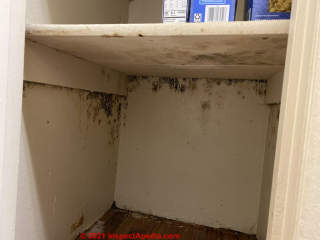 Your photo shows that there is a mold problem on that building without doubt;
Your photo shows that there is a mold problem on that building without doubt;
From your description it sounds as if the cleaning was superficial and therefore inadequate.
Worse, if moldy walls were covered over, a potentially dangerous mold reservoir may have been left in place that could out at particular risk a future visitor or occupant who is mold-sensitive, asthmatic, immune impaired, elderly, infant, etc.
What's needed is a thorough, competent inspection to determine the extent of further cleaning needed and to identify the cause of mold growth - there's no point in removing mold if we don't fix its cause.
A complete set of "what to do about mold " and "how find hidden mold" and so on can be found in the INDEX to RELATED ARTICLES given at the end of any of these pages.
On 2021-07-21 by Helping a friend
I have a friend that was out of town for a few weeks. When he returned to his apartment he found there had been a water leak in the unit above him. His kitchen was the most affected. They took weeks to do anything about it. The evidence of mold was obvious by sight and smell.
It has now been a few months since and he told me they repaired it. I went by his place yesterday and saw they did one of the worst jobs I’ve seen. My biggest concern at this point is the mold growing in so many areas. I have seen it largely in his pantry.
The image I’m adding is the view of the bottom up of the last shelf and wall. There are some streaks from where I started to spray cleaner before I realized what is was and looked around a saw more in other places. Does this appear to be hazardous for him? Do you think if we were to clean all of the areas if it would be okay?
They never even replaced the baseboards so I’m curious if they just slapped some new walling up and called it a day. Thank you for your take and any advice!
Oh this is in Fort Worth, Texas
On 2021-07-16 by inspectapedia.com.moderator
@Scott,
when there is more than 30 sqft of contiguous mold you'd normally use a professional cleaning company;
There could be health risks;
In my opinion and experience, just spraying mold killer alone isn't an effective treatment;
Remove the mold
Clean the surfaces
Fix the cause
Protect the workers and the rest of the building during the procedure
See details at
MOLD CLEANUP, DO IT YOURSELF
That article and a few other pages I recommend at the bottom of that article will be more thorough than I can re-create here typing off-the-cuff
Don't hesitate to ask followup questions
On 2021-07-15 by Scott
@inspectapedia.com.moderator, Thanks for your response. My wife is thinking about remediating ourselves using Concrobium... spraying it and/or using a defogger. Not sure what advice you might give us based on the pictures... what to wear, what products to use, etc... We are planning on reading what you wrote, but thought you might have some additional input or suggestions.
On 2021-07-14 by inspectapedia.com.moderator (mod)
@Scott,
Lots of mold on wood and other surfaces,
Looks quite wet,
Possible hazard to occupants in space above.
In the Article Index
See MOLD ACTION GUIDE
probably want basement at negative air pressure vs upstairs
On 2021-07-14 by Scott - diagnose and fix floor framing mold problem
...
On 2021-07-13 by inspectapedia.com.moderator (mod) - how to post images at InspectApedia.com
@Scott,
you need to simply use the Add Image button and then navigate to a image file on your computer such as a JPG, GIF, IMG, or gif.
PDF's won't post. And you're correct you can only post one image per comment. But of course you can post as many comments as you need.
On 2021-07-13 by Scott
Unfortunately, We aren't at the home and I didn't take pictures of the fridge before it was cleaned. I think this only lets me attach 1 image, so I might do this a few times to share additional images of the beams.
On 2021-07-13 by n (mod)
@Scott,
It would be helpful to see a photo; both distant showing the whole side of the black-spotted fridge, or on other surfaces
and a sharp closeup of the pattern so that I can see growth or deposit details.
often we can recognize mold without any sort of microscopic exam
Or you can Continue reading at MOLD APPEARANCE - WHAT MOLD LOOKS LIKE
Or you can see MOLD APPEARANCE on VARIOUS SURFACES photo guide to what mold looks like growing on more than 100 different building surfaces
that includes mold as it shows up on refrigerators
On 2021-07-13 by Scott - mold in basement that recently had lots of moisture and very high humidity
We have an old home with a basement that recently had lots of moisture and very high humidity. The only thing in it is a fridge, but within a week, black spots appeared on the side and front of the fridge and within a 5-6' radius of the fridge, many of the wood beams above had white spots and larger stains.
We think it might be mold, but trying to identify it before making a decision on what to do. Hoping you might shed some light on the subject.
On 2021-06-16 by inspectapedia.com.moderator (mod)
@Andrew, 2 pints, one for each InspectApedia moderator.
And if you can manage a sharp-focused much-closer photo of that "dust" I'd like to see it. Usually we can identify carpenter ant frass.
On 2021-06-16 y mak.church (mod)
@Andrew,
Please do let us know the outcome of the treatment!
On 2021-06-16 by Andrew
@inspectapedia.com.moderator, The dust is right by the damaged wood and I can‘t see how it can be from anywhere but the wood. The area has been thoroughly cleaned and woodworm treatment has been applied.
We wait to see what happens next.
Many thanks for your comments - I‘ll buy you a pint :)
On 2021-06-13 y inspectapedia.com.moderator (mod)
@Andrew,
That's certainly insect damage, perhaps carpenter ants.
But that frass is usually wood-colored - sort of light tan, not pure white. Maybe it's just an artifact of the photos? Is that "dust" you mention right under the area of insect activity? Have you seen ants? Have you looked at the dust under magnification to see if it's wood fragments?
On 2021-06-13 by Andrew
@danjoefriedman, thank you. That makes sense. I just had another look and I think it is a burrowing wood creature. Wood worm? That should be treatable
On 2021-06-12 by danjoefriedman (mod)
@Andrew,
From your photo I can't tell what that dust is. I think it might be a good idea to take a simple sample of it and have it examined by forensic lab. Once the material was identified from the dust it should be easy to point to a source.
On 2021-06-16 by inspectapedia.com.moderator - white "dust" on floor traced to insect infested wood above
@Andrew, 2 pints, one for each InspectApedia moderator.
And if you can manage a sharp-focused much-closer photo of that "dust" I'd like to see it. Usually we can identify carpenter ant frass.
Please do let us know the outcome of the treatment!
On 2021-06-16 by Andrew
@inspectapedia.com.moderator, The dust is right by the damaged wood and I can‘t see how it can be from anywhere but the wood. The area has been thoroughly cleaned and woodworm treatment has been applied.
We wait to see what happens next.
Many thanks for your comments - I‘ll buy you a pint :)
On 2021-06-13 1 by inspectapedia.com.moderator
@Andrew,
That's certainly insect damage, perhaps carpenter ants.
But that frass is usually wood-colored - sort of light tan, not pure white. Maybe it's just an artifact of the photos? Is that "dust" you mention right under the area of insect activity? Have you seen ants? Have you looked at the dust under magnification to see if it's wood fragments?
On 2021-06-13 by Andrew
thank you. That makes sense. I just had another look and I think it is a burrowing wood creature. Wood worm? That should be treatable
On 2021-06-12 by (mod) - diagnose white dust problem.
@Andrew,
From your photo I can't tell what that dust is. I think it might be a good idea to take a simple sample of it and have it examined by forensic lab. Once the material was identified from the dust it should be easy to point to a source.
On 2021-06-11 by Andrew
We have a white dust problem. It’s in the lobby of a new build house. The construction is insulated concrete formwork with mechanical ventilation so the house is impeccably dry and air tight.
If we vacuum the dust it re-appears in a few days.
The dust is fine and dry. We tried putting ant powder down so some of the staining is from that. What can be creating the new particles of dust?
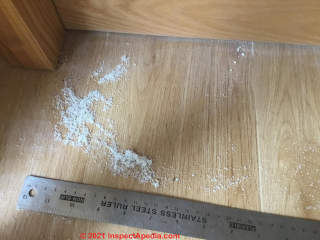
On 2020-10-22 by (mod)
Try using the "add image" button, Judith; you can post an image file - that will appear after moderator approval.
On 2020-10-22 by Judith Lee
Here is additional photo of white substance that collects on wood mostly but this is metal. It was tested and it is not mold
White powdery spots showing up on interior wood floors and lower cabinets and some wood furniture. Had it tested and it is not mold.
On 2020-10-21 by (mod)
Matt: I like to go to the most-suspect place(s) and try a couple of invasive cuts - 2" x 4" is enough - to get a look inside of those suspect cavities.
On 2020-10-21 by Matt
Thank you so much for the prompt reply. I very much hope you are correct. The house is in Queens, NY and was built in 1940. Some of the walls have been replaced or covered with dry wall but this particular wall is original and I'm 99% sure is plaster. Do you think it is possible this growth could be from residual moisture trapped behind the wall from the original leak back in July or does this seem to indicate a continuous accumulation of water?
It is quite a bit of accumulation I think. Besides continuing to try to locate and repair any leak or source of water, what other next steps might you recommend? Remove build up and monitor the area periodically? Thanks again. Matt
On 2020-10-21 by (mod) - water leak signs, risk of hidden mold
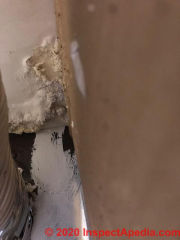 Matt:
Matt:
Your first photo shows what looks like a soft crystalline bloom of efflorescence, perhaps from a plaster wall. (It'd help to know the country, city, & age of the building and to know if the surfaces are plaster).
See examples at EFFLORESCENCE SALTS & WHITE DEPOSITS
Of course your photos show several areas where there could be hidden mold if water leaked into them, such as behind cabinets and on the wall cavity or ceiling side of plaster or drywall.
Unless you are someone at particular health risk you can safely remove mold and water-damaged materials as long as the total area of contiguous mold is less than about 30 sq.ft. For larger areas of mold contamination (that you might find during the job) you'd want to hire a professional.
Watch out: using a moisture meter is helpful but no moisture meter can reliably detect mold or damage from prior leaks in areas that are now dry. Moisture meters detect only moisture (or possibly effects of moisture that changed the electrical conductivity of building materials.)
On 2020-10-21 by Matt
Here is a shot of the area in question. Only the upper corner behind and above the cabinet is testing positive for moisture. There is a bathroom directly this but because there was this significant roof leak a few month back in this same corner area, I would tend to think this is related to that and not a plumbing issue.
No way to know without ripping up the whole bathroom though. We have since had the roof replaced so I am not sure why we are still seeing moisture which is a concern.
If this substance is mold, do you think we can have someone come in to remove and then just patch the plaster or do we need to remove down to the wood lathe and set up blowers as we did previously for the other damage?
Could we safely remove and repair it ourselves? Thanks again. Matt
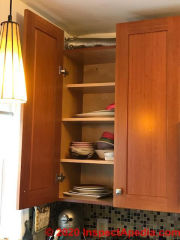 ...
... 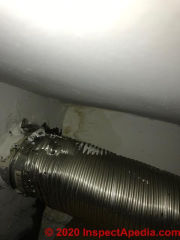
On 2020-10-21 by Matt
Hi Mr. Friedman, This is a great site. I hope you can assist. We had a roof leak back in July. Water Remediation company dd a lot of testing for residual moisture and removed a lot of material which has since been replaced. One area where we had an active leak was in the corner of the kitchen.
They checked the backsplash with a device that checks for moisture and didnt find any but they never checked this hard to reach corner.
Now I see some sort of substance underneath the paint and when I climbed up and checked, the area is still showing moisture. Can you advise what I might be looking at here? I will send a couple images. Thanks so much for your help! Matt
First photo is now at the top of this discussion - Ed.
On 2020-10-05 - by (mod) -
water damage, mold, efflorescence, & thick house dustSavannah
I see some mold and some rod and some efflorescence and evidence of leakage.
Your last photo shows what looks like an accumulation of house dust along the edge of floor baseboard trim. If there have been pets in the house that would often increase the dust level.
Please see
MOLD APPEARANCE on VARIOUS SURFACES - INDEX photographs of the appearance of mold on various building materials & contents.
On 2020-10-05 by Savannah
Is this mold?
...
On 2020-07-08 by (mod) - is this mold?
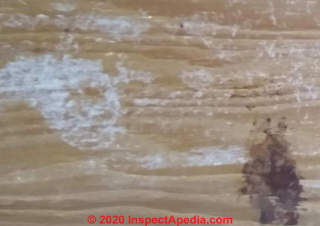 You're welcome to try posting a very sharp close-up photo and I might be able to offer more remarks.
You're welcome to try posting a very sharp close-up photo and I might be able to offer more remarks.
Or look yourself for evidence of cement - in the history of the construction
- or of other substances that are inorganic.
On this blurry enlarged crop of your photo it doesn't look like mold.
Also,
If you think that it is mold,
and you'll find that "killing" mold is never the proper nor useful objective
- some "dead" mold is still harmful, toxic, or pathogenic; the object is to remove the mold and find and fix the cause of its growth.
On 2020-07-08 by Anonymous
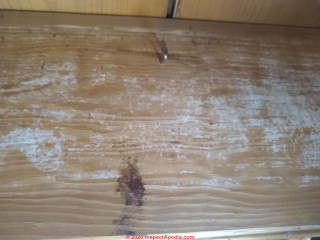 OK thanks for the quick reply! Would a closer picture be better? Yes it is a Joist.
OK thanks for the quick reply! Would a closer picture be better? Yes it is a Joist.
On 2020-07-08 - by (mod) -
I note that the white material is only on the wood (joist?) and not on the abutting wood surface
- suggesting that if this is white mold, it's not an active growth.
But from the photo I can't tell if this is leftover concrete from having used the wood as a concrete form,
or something else.
On 2020-07-08 by Anonymous
Is this white mold? If so whats a good way to kill it?
On 2020-06-13 - by (mod) - white fungal growth & probable black mold growing on wood porch underside
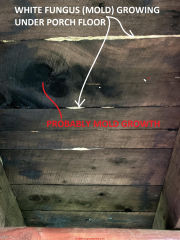 Rickey
Rickey
If your question is about the white spongy material growing between abutting sides of rough-sawn wood flooring, that' s fungus
a combination of water and probably protection from drying effects of sun and air movement as well as using un-treated lumber are at the root of this typical mold growth.
On 2020-06-11 by Rickey Morris
What is this?
It’s growing rapidly on my porch.
I have not sprayed any foam in this spot or any others of the house.
It’s a solid wood house.
Poked it with a knife and it has a consistency of caulking.
On 2020-01-12 - by (mod) -
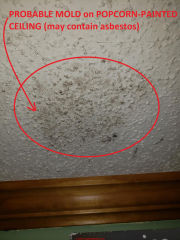 Jason
Jason
That could be a fungus or mold growth; Curiously I don't see water stains that would confirm a leak from above but that's a factor to investigate.
If this is all you've got it's a DIY project. Spray cleaner and a terry cloth towel wipe-off;
Ultimately if we think there's water from above the risk is mold on the hidden side of the ceiling drywall; then it's a cut-out and repair job;
Watch out: depending on ceiling age that popcorn spray could contain asbestos.
See POPCORN CEILING PAINT TEXTURED ASBESTOS
On 2020-01-11 by Jason R
This an isolated spot on the ceiling in my basement. Some stuff was stored close to it so I'm curious if it looks like mold or maybe just stuff scraping against the ceiling when items were being moved.
Thanks
On 2019-09-16 - by (mod) -
It could since it's causing air currents to move upward above the heater. Astrologer heater is installed and used exactly as directed by the manufacturer or you risk a fatality or building fire.
On 2019-09-10 by elizabeth
would the use of a portable heater in the bedroom cause soot-like marks on wall
On 2019-07-09 by Anonymous
I don't usually use commercial cleaning products because I'm very sensitive to smells, toxins, VOC's, perfume, etc. Would it be effective to spray vinegar on the surfaces? Also, do you think it looks like mold, or is it hard to tell?
On 2019-07-08 - by (mod) - moldy furniture
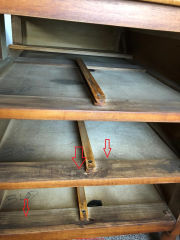 Anon, thanks for the question and photos - yes the current Comments Box code permits just one image per comment but as you figured out you can post more comments and thus more images.
Anon, thanks for the question and photos - yes the current Comments Box code permits just one image per comment but as you figured out you can post more comments and thus more images.
I'd simply use a household spray cleaner on the mold-suspect wood surfaces, then dry the desk thoroughly. Once it's dry you can if you wish, improve its moisture resistance on those previously un-coated wood surfaces with a light spray of clear shellac or lacquer. Improving moisture resistance improves mold resistance.
On 2019-07-07 by Anonymous - brown or black mold growing in desk drawer cavity?
Here's the second picture where the other side of the desk drawers were removed and there is discoloration.
Again, no musty smell and no powdery or any unusual texture. Couldn't figure out how to post more than one.
On 2019-07-07 by Anonymous
I'm in the process of moving and when I took the drawers out of a desk, I noticed a discoloration on the interior that looked funky. I'd never seen the inside where the drawers go so I had/have nothing to compare it to.
The desk doesn't smell moldy and when you wipe your finger across the discolored areas,it's not dusty, fuzzy, slimey, or anything. It just feels like the wood. But I wanted to run this past you for your input. My husband said the discoloration is just over-spray from the stain, but I wanted to get your input. Here's a picture:

On 2021-10-18 by Inspectapedia Com Moderator
do take a look at the article I suggested
On 2021-10-18 by Green and Black Crystals Growing Under Sink
@inspectapedia.com.moderator, Thanks - I was worried that it’s mold - but it’s hard and dry and flakes off/crumbles like a crystal/dirt (not what I think of as typical damp mold?).
On 2021-10-18 by Inspectapedia Com Moderator
@Green and Black Crystals Growing Under Sink,
probably caused by moisture, that might be mold, not crystals, or it might be efflorescence - that can appear in many colours
See details at EFFLORESCENCE SALTS & WHITE DEPOSITS
https://inspectapedia.com/Wet_Basements/Efflorescence-White.php
On 2021-10-18 by Green and Black Crystals Growing Under Sink
Found Green and black crystals under bathroom sink. No apparent dampness anywhere. What is this/what is causing this? It’s not isolated to one spot but around various areas. It’s possible it has been there for some time and I haven’t noticed.
On 2021-08-25 by Kim
@inspectapedia.com.moderator, Thank You!! Will do!
On 2021-08-24 by Inspectapedia Com Moderator
@Kim,
You might print and give to the bleachers
BLEACHING MOLD, Advice https://inspectapedia.com/mold/Bleach_Mold_Contamination.php
and
MOLD KILLING GUIDE https://inspectapedia.com/mold/How_to_Kill_Black_Mold.php
On 2021-08-24 by Kim
@inspectapedia.com.moderator, Thank You! I thought so!
The maintenance man sprayed it with bleach solution so now it is gone. But they said it was not mold! Not even Confident that the guy they have doing the mold remediation is even certified he cleans carpets for the college. 🙄
Frustrated as this apartment is my daughters and her roommates while they are at college. I have been in contact with the apartment manager but I guess that does no good if you have someone that doesn’t know what they’re doing.
The spot on the wall that looked worse than this the Maintenance sprayed with bleach for the supposedly mold remediation man came. He said that was from a leak.
When I first contacted the apartment manager to fuss about this I told her the source of the problem has to be found and fixed you can’t put a Band-Aid on it. GEEZ!
On 2021-08-24 by Inspectapedia Com Moderator
@Kim,
The photo is a bit blurry, but that sure looks like mold to me. There's little doubt;
IF that is drywall (Gypsum board) then it cannot be properly cleaned of mold; in that case the material should be replaced.
Find the mold, Remove it, and find and fix its cause.
On 2021-08-24 by Kim
Mold issue in apartment but mold remedation and cleanup company says this is not mold. What could it be? It is the ceiling in the utility closet.
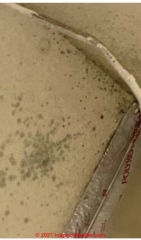
On 2021-07-28 by Trill - dried peeling stuff on roof sheathing, viewed from attic, after leaks
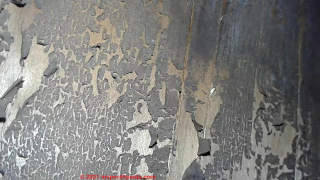 @inspectapedia.com.moderator, Ok well do that thank you for your advice! Sorry for the confusion and all
@inspectapedia.com.moderator, Ok well do that thank you for your advice! Sorry for the confusion and all
On 2021-07-28 by inspectapedia.com.moderator (mod)
@Trill,
No worries, it's often difficult to get things clear when we have to rely just on text send a photo.
No one and nothing at this website requires that you be a building expert in order to ask a question.
Now that we understand that the black peeling stuff is on the inside of the roof decking as seen from the underside or attic side we can see that you had a significant moisture problem in that space.
I'm not sure what the material is that is shown in your photo.
It would make sense to clean it off and perhaps to spray a fungicidal sealant on those surfaces just to be on the safe side.
Usually on page of search box on this website to search for
FUNGICIDAL SEALANTS
To see details
On 2021-07-28 by Trill
@inspectapedia.com.moderator, I'm sorry I'm really not good with words so I must have messed something up. the shingles are on the outside. There is no wood outside only shingles. It looks like a normal shingled roof out there
Then from the inside when you go up and look at the underside of the roof it is wood that is dark and like how it looks in the picture. I took the picture with flash in the inside of the house in the attic looking up at the wood. So its just like a normal shingled roof and a normal attic except on the inside of the attic the wood is dark.
The vent wasn't nailed in right and it let water get to the inside getting the attic all wet until we fixed it. So the wood inside got wet along with the insulation and drywall.
We fixed the leak now nothing gets wet inside, the shingles keep the water outside the house but the wood is all dark on the inside of the attic. But the black is flaking off and doesnt smell like mold.
I think that's clearer maybe I'm sorry Im just really bad with words
On 2021-07-28 by inspectapedia.com.moderator (mod)
Trill:
I'm baffled - we're somehow mis-communicating.
There is no way that plain raw plywood would be exposed on the finished, upper, exposed-to-weather roof surface, so I don't understand your photo.
On 2021-07-28 by Trill (no email)
re-posting - accidentally delete by mod
@danjoefriedman, I don't know the slope of my roof but I'd guess it's a conventionally sloped roof. It's definitely not flat and I couldn't imagine water pooling on it with the slope it has
The roof was inspected by a roofer who confirmed the vents were leaking and replaced them. There have been 2-3 large thunderstorms since then. We were in the roof during them and didn't see any leaking. There has been no signs of water since the vents were replaced it's very dry.
I am not sure what the material is exactly but it's definitely shingles nailed to
some kinda wooden sheet. Were in southern ontario if that helps at all. I can find out if it would help to figure out what it is
On 2021-07-28 by (mod)
@Trill,
I don't understand your roof structure nor materials.
YOu say it's plywood, but plywood would not normally be left as the finished-roof surface so I'm a bit stymied.
ALso where we see algae formation on a low slope or "flat" roof it's usually because there is excessive ponding - standing water in areas more than 24 hours after the last rainfall. Such low spots wear or damage roofs and increase the chances of a leak.
So it looks as if more inspection and more details are needed .
Search InspectApedia for LOW SLOPE ROOFING and find and read https://inspectapedia.com/roof/Low_Slope_Roofing.php
On 2021-07-28 by Trill
@inspectapedia.com.moderator, wow thanks for the quick reply. So if it's dried algae should we have it cleaned off or is it just aesthetic
On 2021-07-28 by inspectapedia.com.moderator (mod)
That looks like dried algae and dirt, though I could be wrong as I have no information about the location or situation..
On 2021-07-28 by Trill
Hi, so I have this roof that had some leaky vents. We stopped the leak but all the plywood is very dark.
It's very uniform except in a few places where it's flaking off like paint maybe. Is this mold?
On 2021-07-10 by inspectapedia.com.moderator (mod) - house dust at door hinge is not mold
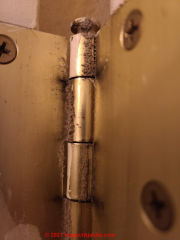 @Amanda,
@Amanda,
That's not mold.
It looks like a combination of house dust from air leaks at the hinge syringe perhaps wear-debris in the hinge - a loss of lubricant at the hinge pin makes the surfaces near the hinge pin sticky and thus retain more dust than surrounding surfaces. .
But you say this is a new house. I certainly wouldn't expect this level of dust accumulation on a brand-new home.
Is it possible that someone was running an exhaust fan with the door closed ?
Air leaks.
Look also for sources of dust: pets, carpets, construction, etc.
On 2021-07-10 by Amanda
Bought a new house, found this brown fuzzy stuff in outlets and behind them.
Also around the door frame to our utility room. Thought maybe from smoking but when iwipe is a green/ black color on the rag.
Any guesses? Do I need to mold test? The home is in Colorado.
On 2021-02-17 by (mod)
Eric
With the apology that I'm not certain from just your photo, that looks to me as if there is a termite or some other insect infestation.
You might look further and post another photo or two, you can post one photo per comment, and you might then one to ask for an inspection by a licensed Pest Control person.
On 2021-02-17 by Eric
Hi removed baseboard trim in walk-in closet and found this brown sand like substance any idea what it could be only in two small spots in a 10x10 room
[Photo above]
On 2018-10-12 - by (mod) -
Looks like mold, a small amount. Check for leaks above.
On 2018-10-12 by Linda
Wonder if you can teel if this is mold on my laundry room ceiling? Not an issue with moisture (main floor) - but have smelled musty smell - and have had dozens of bees -yellow jackets- inthe room as well,probably came in from the wall where there is a gap between a pipe and the sheetrock.
Appreciate your help! I have allergies and am concerned about removing this myself too.
IMAGE LOST by older version of Clark Van Oyen’s Comments Box code - now fixed. Please re-post the image if you can. Sorry. Mod.
On 2018-06-10 - by (mod) -
Let me know what you see including water leakage signs. If water leaked in the ceiling you may have a bit of mold cleanup to do.
On 2018-06-10 by Jake
Yes it part of a vent or exhaust system. But I don't really use this bathroom. It sit on 1st floor, right below the 2nd floor bathroom and there was a issue with caulking on 2nd floor which has been completed about 2 months now.
However this fluffy stuff continues to grow. Hope it's safe to Vaccum and get a closer look.
On 2018-06-09 1 - by (mod) -
To me that looks like dust
. Is that like part of a vent or exhaust system?
You could try just vacuuming it out.
Once you've done that take a look for any signs of water stains or leaks. If you see water. stains delay electrical boxes unsafe and needs repair and of course you would need to find and fix the leak.
On 2018-06-09 by Jake
Is this Efflorescence or mold? And how do I remove it? White and fluffy looking only on this bathroom light socket/jbox.
IMAGE LOST by older version of Clark Van Oyen’s Comments Box code - now fixed. Please re-post the image if you can. Sorry. Mod.
On 2018-06-09 by Jake
Is this Efflorescence or mold? And how do I remove it? White and fluffy looking only on this bathroom light socket/jbox.
On 2018-05-01 - by (mod) -
Yes Scott that white could indeed be a white mold growth. Look at the roof sheathing plywood just along the rafter and you'll see water stains and damage - suggesting a roof leak; the white efflorescence deposits on the block party wall in the background may also be from leaks.
On 2018-05-01 by Scott
Mold on the attic rafters? It seems to follow the grain. Sap?
IMAGE LOST by older version of Clark Van Oyen’s Comments Box code - now fixed. Please re-post the image if you can. Sorry. Mod.
On 2018-03-19 - by (mod) -
Carol
You might use the page top EXPERTS DIRECTORY to hire a home inspector or you might review the building with a painter or insulation contractor.
On 2018-03-18 by Carol
Black streaks on the walls and ceilings following 2 x 4's I'm assuming is thermal tracking Who do I contact to find out for sure where what type of contractor
On 2019-01-02 by (mod) - white crystals on road emergency bag
I agree that the material [shown in the photo above] looks like crystals, not a fungus
. If you look inside the bag and see no deposits whatsoever in the corresponding area of the fabric then own would think that some salt or chemical (perhaps from a leaky flare) got onto the fabric.
More photos and examples of crystalline salts are at EFFLORESCENCE SALTS & WHITE DEPOSITS
where in that article I'll add to this conversation in the article section EFFLORESCENCE CRYSTALS from CHEMICALS & SALTS as that will also help other readers.
Thank you for the question and the excellent photo.
On 2019-01-02 by Any idea on what this is?
Found these white crystals [shown above] growing on a road side emergency bag I have under my back seat.
It did not feel wet, I opened it up and the flares and everything else seemed just fine, also no crystals inside. I was thinking salt or mold but it's just localized to that one spot.
On 2018-12-21 by André
CAN se measure water in french house drain witch à thermal camera?
Thanks
On 2018-11-01 by (mod) - very dirty air register grille
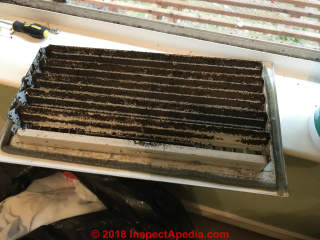 There could be mold on your air register but there is so much debris that is difficult to see what you have in the photo.
There could be mold on your air register but there is so much debris that is difficult to see what you have in the photo.
The most common deposit on Supply Air registers is house dust, principally fabric fibers and a skin cells.
On 2018-10-31 by Shannon
Have some ceiling air vents that look like this. Could this me mold??
On 2018-10-23 by (mod) - white mold on roof truss
I see what looks like a white fungus on the truss diagonal member and black water/mold stains on the flat 2x4 in the lower portion of the photo.
On 2018-10-23 by Randy
In my attic. Is it just staining?
On 2018-10-19 by (mod) -
Linda
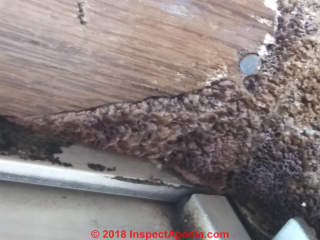
I'm not sure what we're seeing, as the photo is a bit blurry, but considering the surrounding water stains I suspect it's a dried-out fungus.
Most likely the total square footage is trivial and thus would be a candidate for DIY cleaning using a household cleaner.
If your windows are leaky, single glazed, lack a storm window, or are in an area of high moisture, the high level of condensation on the window invites mold growth. Those are things to address.
On 2018-10-19 by Linda salzer
I found this hard, brown, growth inside corner of my window, cannot find anything close on the internet, does anyone know what this is?
...
Continue reading at MOLD APPEARANCE - STUFF THAT IS NOT MOLD or select a topic from the closely-related articles below, or see the complete ARTICLE INDEX.
Or see MOLD APPEARANCE, STUFF THAT'S NOT MOLD FAQs-2 - more-recent Q&A and photos of stuff thought not to be mold
MOLD APPEARANCE on VARIOUS SURFACES - INDEX - photographs of mold contamination on various building materials & contents.
Or see these
Recommended Articles
- MOLD APPEARANCE - STUFF THAT IS NOT MOLD
- BASKETBALL MOLD SYNDROME - BBMS
- EFFLORESCENCE SALTS & WHITE DEPOSITS
- THERMAL TRACKING BRIDGING GHOSTING
- STAINS in BUILDINGS, FAQs
- MOLD APPEARANCE, STUFF THAT'S NOT MOLD - FAQs
- MOLD APPEARANCE, STUFF THAT'S NOT MOLD FAQs-2
- MOLD APPEARANCE, STUFF THAT'S NOT MOLD FAQs-3
- MOLD / ENVIRONMENTAL EXPERT, HIRE ?
- STAIN DIAGNOSIS on BUILDING INTERIORS
Suggested citation for this web page
MOLD APPEARANCE, STUFF THAT'S NOT MOLD - FAQs at InspectApedia.com - online encyclopedia of building & environmental inspection, testing, diagnosis, repair, & problem prevention advice.
Or see this
INDEX to RELATED ARTICLES: ARTICLE INDEX to MOLD CONTAMINATION & REMEDIATION
Or use the SEARCH BOX found below to Ask a Question or Search InspectApedia
Ask a Question or Search InspectApedia
Questions & answers or comments about how to identify stuff in buildings that is not mold but may be mistaken for it. Stains, deposits, growths, etc.
Try the search box just below, or if you prefer, post a question or comment in the Comments box below and we will respond promptly.
Search the InspectApedia website
Note: appearance of your Comment below may be delayed: if your comment contains an image, photograph, web link, or text that looks to the software as if it might be a web link, your posting will appear after it has been approved by a moderator. Apologies for the delay.
Only one image can be added per comment but you can post as many comments, and therefore images, as you like.
You will not receive a notification when a response to your question has been posted.
Please bookmark this page to make it easy for you to check back for our response.
IF above you see "Comment Form is loading comments..." then COMMENT BOX - countable.ca / bawkbox.com IS NOT WORKING.
In any case you are welcome to send an email directly to us at InspectApedia.com at editor@inspectApedia.com
We'll reply to you directly. Please help us help you by noting, in your email, the URL of the InspectApedia page where you wanted to comment.
Citations & References
In addition to any citations in the article above, a full list is available on request.
- In addition to citations & references found in this article, see the research citations given at the end of the related articles found at our suggested
CONTINUE READING or RECOMMENDED ARTICLES.
CONTINUE READING or RECOMMENDED ARTICLES.
- Carson, Dunlop & Associates Ltd., 120 Carlton Street Suite 407, Toronto ON M5A 4K2. Tel: (416) 964-9415 1-800-268-7070 Email: info@carsondunlop.com. Alan Carson is a past president of ASHI, the American Society of Home Inspectors.
Thanks to Alan Carson and Bob Dunlop, for permission for InspectAPedia to use text excerpts from The HOME REFERENCE BOOK - the Encyclopedia of Homes and to use illustrations from The ILLUSTRATED HOME .
Carson Dunlop Associates provides extensive home inspection education and report writing material. In gratitude we provide links to tsome Carson Dunlop Associates products and services.


